Wisconsin’s most important Native American location
Introduction
This is the first in a series of blog posts about ancient Native American sites across the US that I have visited and photographed. To see others in the series, click the “Ancient America” category from the home page.
Along with photography, I have a strong personal interest in travel and history. Those three passions have merged into a series of visits across the US to ancient Native American sites. Over the past 15 years, I have visited more than a dozen locations that feature mounds, cave art, petroglyphs, or are simply a place where Native history occurred. This series will document them all systematically.
Become a Patron!
If you enjoy reading this story, please help me create more like it by supporting me on Patreon.
Welcome to Aztalan
Aztalan State Park is a 170-acre patch of rolling prairie surrounded by lovely, pastoral dairy farms. It was once home to a significant Mississippian-era civilization that thrived from 900 – 1200 CE (although some sources claim 1300). The mound-builders at Aztalan were part of the same culture that also built mounds in places like Cahokia, Illinois. They had trade networks ranging across the midwestern US, the Great Lakes region, and as far south as the Gulf of Mexico (Wikipedia). The remains of Aztalan were “discovered” by settlers after Indian removal in the 1830s.
About Mississippian culture
The Mississippian culture of Native Americans (800-1600 CE) was the last culture of natives to exist prior to European contact. The culture originated in the Mississippi River valley about 1,000 years ago and spread across the midwest and the southeastern US. It was characterized by massive earthworks such as mound-building. Some mounds were 100 feet high and were used for ceremonial or political reasons (source). The villages were usually surrounded by a wooden stockade or palisade, coated with stucco to create a wall, and were often sited near rivers or streams. The Mississippian culture was artistically rich, leaving behind art objects like carved stone sculptures, and decorated pottery and personal items.
Books about Aztalan on Amazon
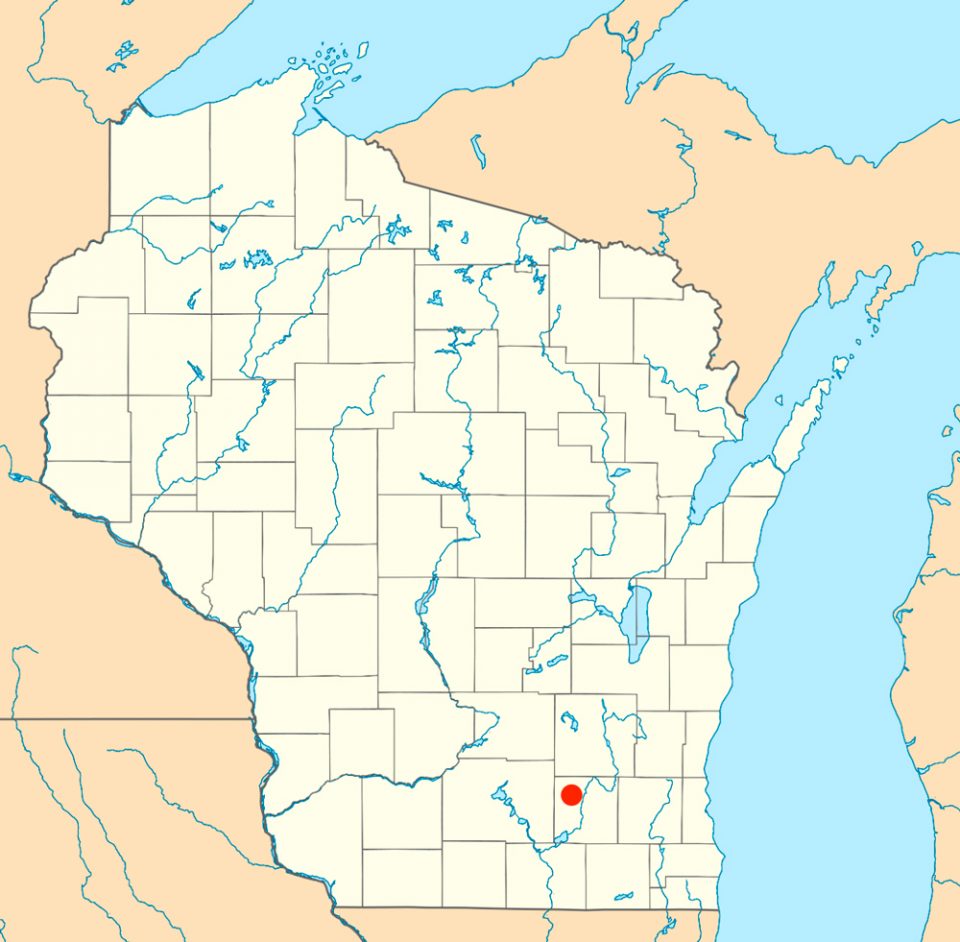
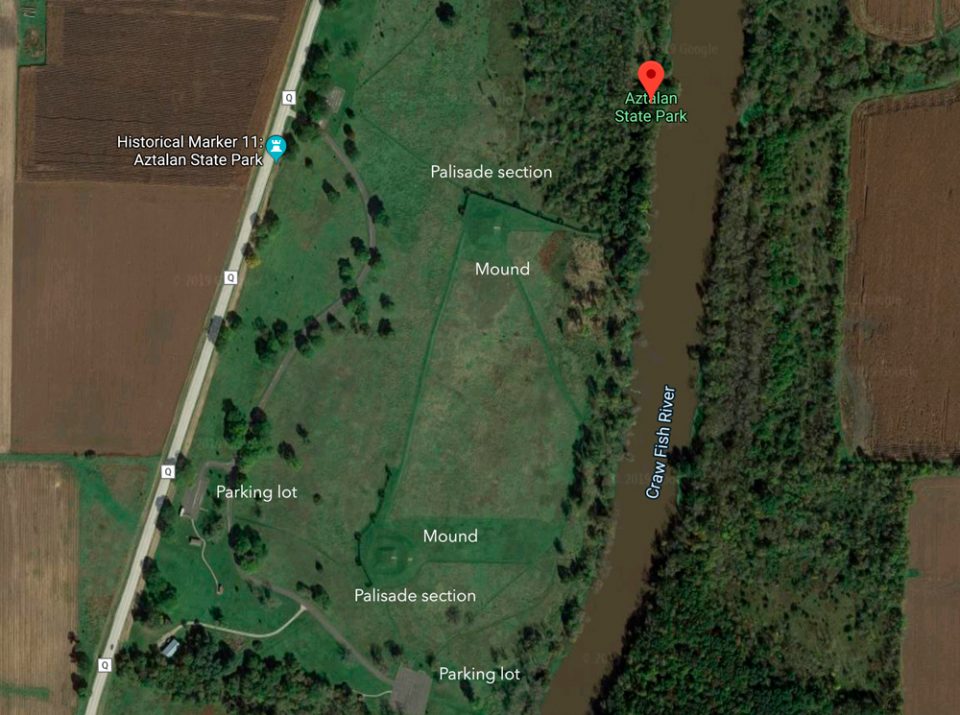
Visiting the park
While living in Wisconsin, I visited Aztalan many times in various seasons. I always found it to be a beautiful and intriguing location. It’s appropriate that it’s located among farms, because Aztalan was Wisconsin’s first farming community (audio tour 5:50). The site is rarely very busy and can be a quiet place for contemplation.
All Wisconsin State parks require either an annual parks pass or payment of a small admission fee (pay at the gate or leave it in a pay box). Aztalan has a parking lot close to Highway Q, and another closer to the Crawfish River.
Aztalan mounds
Aztalan features three man-made terraced platform mounds and one natural knoll. The largest of the mounds (shown in a photo below) held a large wooden structure on top, which may have been a home for leaders or a temple. One of the mounds held a burial, in which ten people were interred in a wooden building on the mound, then burned. The purpose of the third is unknown. 80% of the site has yet to be excavated.

Reconstructed palisade walls
Mississippian villages typically were contained within tall palisade walls. Excavations at Aztalan revealed the locations of original post holes and the new palisade posts have been placed into the original holes, making it an accurate reproduction ( audio tour 3:18 and 14:50 ). The posts would have been laced with a matting of small branches, then covered with a clay mud stucco. An example of that can be seen at Cahokia, Illinois.
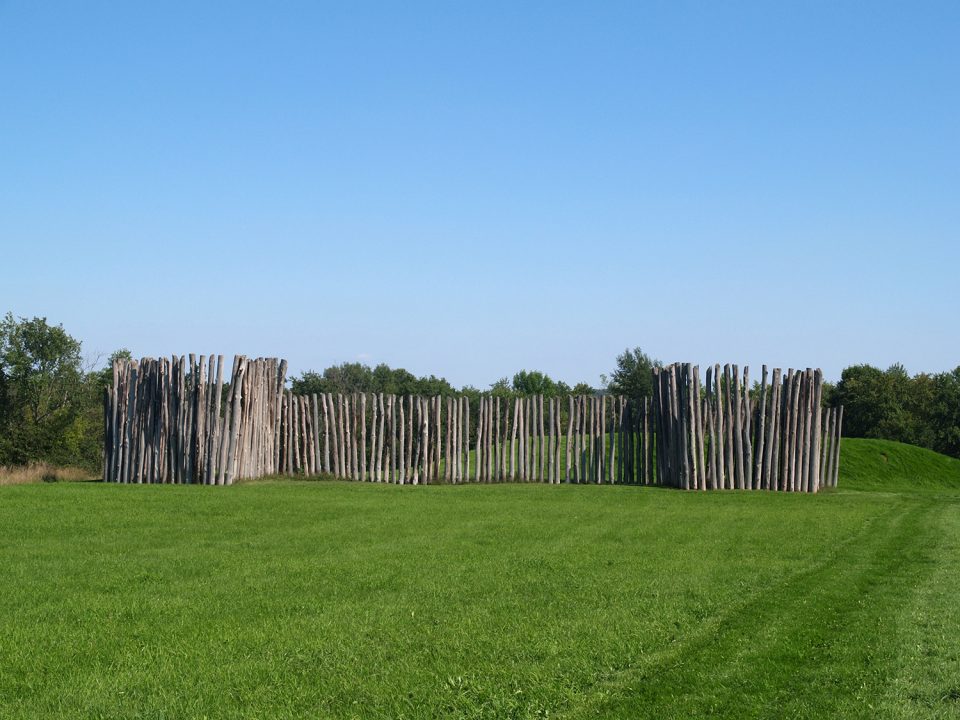
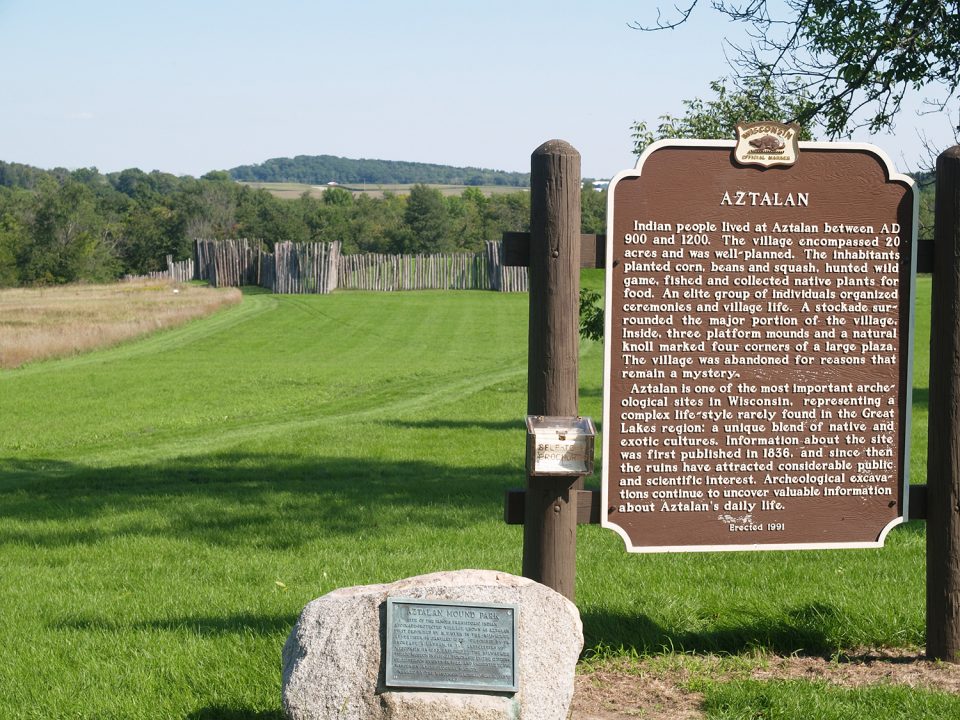
Text from two markers on the grounds at Aztalan
The large wooden sign says the following: “Aztalan — Indian people lived at Aztalan between AD 900 and 1200. The village encompassed 20 acres and was well-planned. The inhabitants planted corn, beans and squash, hunted wild game, fished and collected native plants for food. An elite group of individuals organized ceremonies and village life. A stockade surrounded the major portion of the village. inside, three platform mounds and a natural knoll marked four corners of a large plaza. The village was abandoned for reasons that remain a mystery.
Aztalan is one of the most important archeological sites in Wisconsin, representing a complex life-style rarely found in the Great Lakes region: a unique blend of native and exotic cultures. Information about the site was first published in 1836, and since then the ruins have attracted considerable public and scientific interest. Archeological excavations continue to uncover valuable information about Aztalan’s daily life. Erected 1991.”
The small plaque on the stone says this: “Aztalan Mound Park — Site of the famous prehistoric Indian stockade-protected village known as Aztalan first described by K.F. Hyer in the Milwaukee Advertiser in January 1837. Desribed by Dr. Increase A. Laphan in The Antiquities of Wisconsin in 1855, explored by the Milwaukee Public Museum in 1919-21, purchased by the citizens of Jefferson County in 1922, and presented to the Wisconsin Archeological Society. Marked by the Wisconsin Archeological Society 1927.”
Life at Aztalan
The location was probably chosen by the founders of Aztalan because of its proximity to the Crawfish River, the abundance of deer, and rich farmland for agriculture. They cultivated corn, squash, and beans. They gathered nuts, berries, acorns, and edible plants. They hunted deer, elk, raccoons, birds, and other animals. From the river they caught fish, mussels, and turtles. It was a good location with a wealth of food sources.
Spiritual beliefs
One archaeologist said that there was no concept of religion in Mississippian culture because all aspects of life were inherently spiritual. Political leaders were also religious leaders (audio tour 12:50). Tobacco was grown at Aztalan for spiritual use.
A wooden temple atop one of the mounds housed a sacred fire that was kept burning at all times, and represented the sun. The fire was doused once a year at arrival of green corn, and restarted to symbolize death and renewal. Then the hearths in the individual homes were also put out, and lit anew from the fire in the temple (audio tour 22:50).
Why the Crawfish River location?
Most Mississippian villages were sited close to rivers or streams for many reasons.
- Rivers were an important source of water and food such as fish, freshwater clams, and crawfish. It was common for these communities to build a fish damn in shallow water, which allowed them to easily spear all the fish they could use. Aztalan’s ancient fish dam is still visible during times of low water (audio tour 9:50).
- Rivers were also a common means of transportation and a connection to other communities and to traders.
- At Aztalan, the river location was probably chosen specifically because of a low-water crossing that gave access to timber growing in abundance on the other side of the river.
- And finally, Aztalan was also the location of a spring, which was probably considered a sacred site. Springs were believed to be the entrance to the underworld (audio tour 11:25).
Central plaza and subdivisions
Aztalan was home to between 500-600 people. Residents of Aztalan lived in huts, which may have been either circular or rectangular, and were organized around a large central plaza, which was a common feature of Mississippian villages. The plaza was probably used for community gatherings or ceremonial functions.
Why the fortress walls?
Native Americans in the Mississippian era were part of a warrior culture. Since Mississippian communities expended huge resources creating timber-and-stucco fortifications, we can assume they lived in bellicose times. The founders of Aztalan may have been unwelcome interlopers when they arrived in Wisconsin. Maybe they were unwelcome on another tribe’s hunting grounds. Evidence uncovered around Aztalan indicates widespread violence (audio tour 18:50).
It’s also possible that the clay-coated walls acted as a firebreak, protecting the village from fires intentionally set to clear prairie farmland.
The village was subdivided by inner walls. A housing community was situated in the back, near the river. There would have been a gaming field to play a very popular game known as chunkey, in which highly-celebrated athletes pursued rolling stone disks with spears. There were over 70 lined pits dug into the Earth to hold grain. Middens on the site hold scraps of garbage, broken pottery, clam shells, ash from fires, and evidence of cannibalism?
Evidence of cannibalism?
The Charlotte Observer reported that the 1919 excavation discovered “butchered and charred human bones and heads,” the remains of ancient enemies. It wasn’t uncommon for ancients to collect war trophies, including body parts, which would be displayed on sticks. Sometimes, enemies were eaten, not for sustenance, but as a sign of disdain.
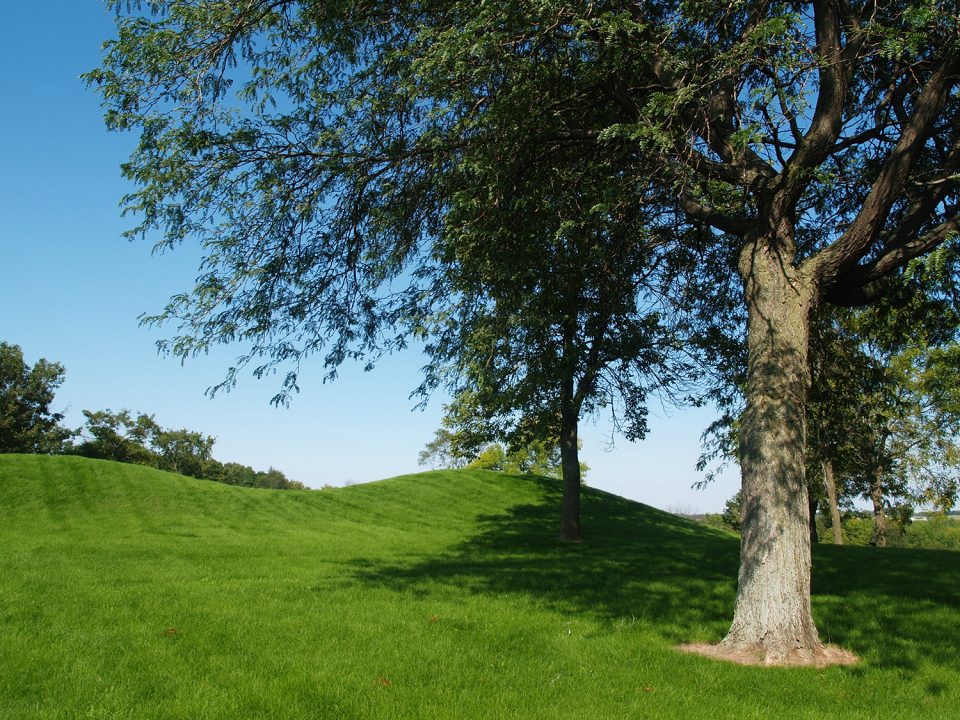
Aztalan abandoned
Why a long-established village would be abandoned by its residents is a mystery. Clues indicate that the village may have been endangered by a severe drought. For now, there are no definitive answers to the question.
Wisconsin Public television video created for Aztalan State Park
Listen to the Wisconsin State Park audio tour for Aztalan
Aztalan Audio Tour: This link will allow you to listen to an MP3 audio file of the Aztalan audio tour. It lasts 37 minutes, and was a source for many of the facts quoted in my post.
Friends of Aztalan State Park
Friends of Aztalan State Park offers a ton of information and resources about visiting the park, as well as plans for a new visitor center, and photographs from recent archeological digs on the site. Check their page here.
Sources
The Charlotte Observer, “Picnic with cannibals: Wisconsin’s Aztalan State Park was home to mysterious, ancient city whose residents ate their enemies,” John Bordsen, October 17, 2013
nativehistoryassociation.org, “Middle Tennessee’s Native American History: The Mississippian Period”
Wisconsin Department of Natural Resources, Aztalan audio tour
Thanks for reading!
Be sure to visit me on Facebook, Google+ or Pinterest, or on my website at keithdotson.com.
~ Keith
